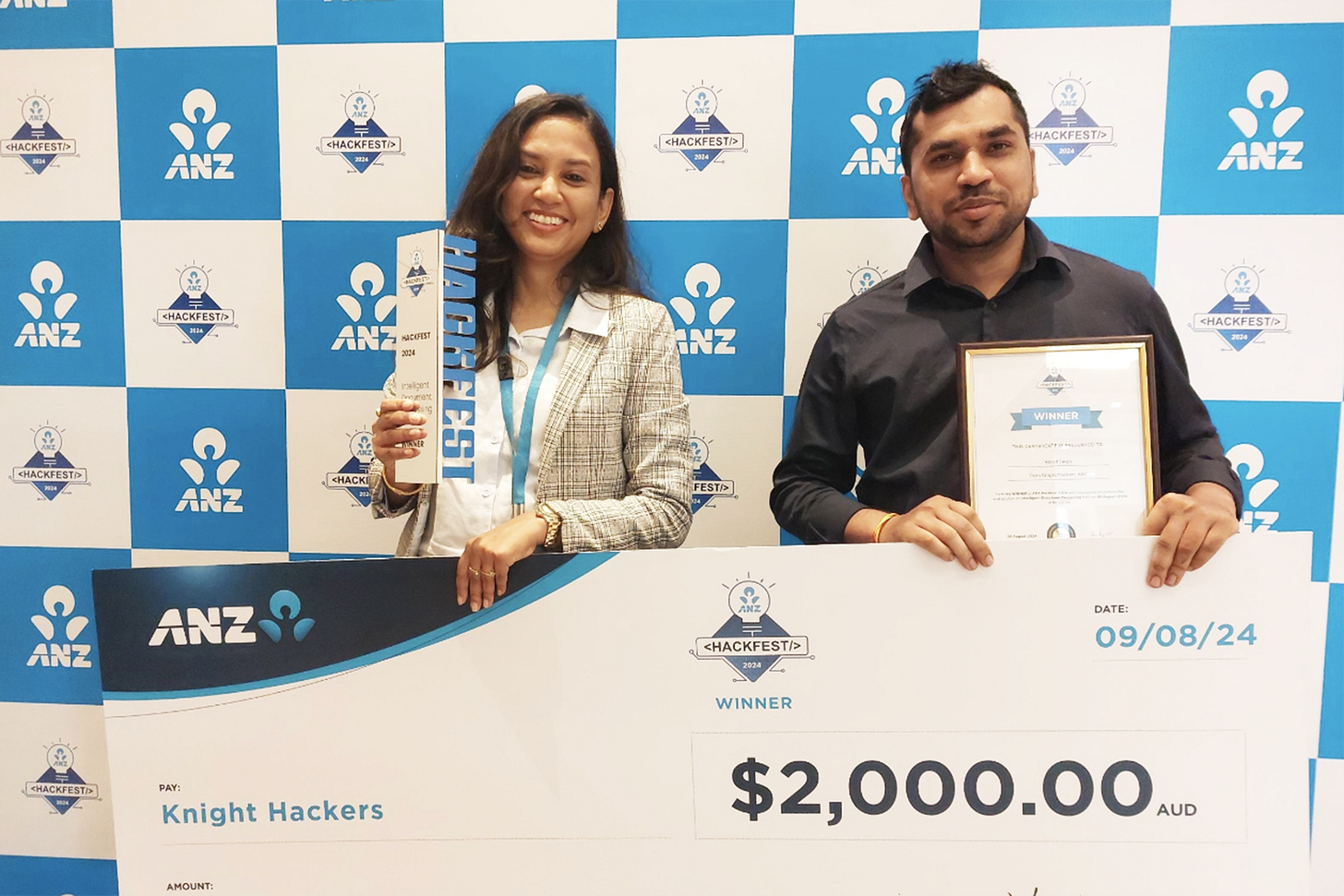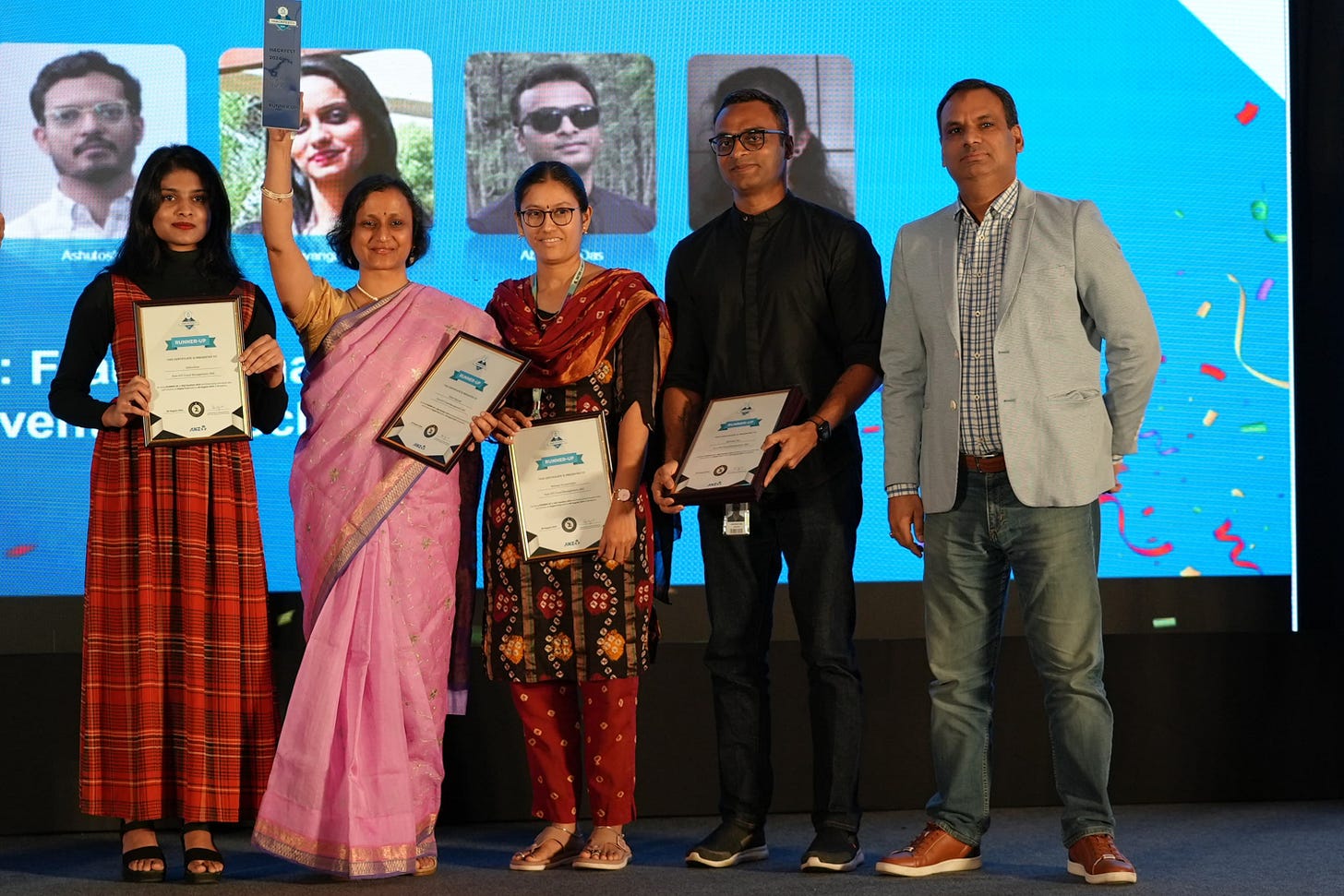Hackfest turns three and makes friends with Gen AI
Profiling the AI solutions of ANZ's two finalists - Knight Hackers & Ghostbusters.
ANZ’s annual hackathon - a challenge our Bengaluru office sets every year to encourage multiregional participation in emerging technologies and novel solutions - turned three in 2024.
The 2024 festival began with a series of ‘Tech Talks.’ Over four weeks AWS, Microsoft, Cognizant, Google, MIT, PWC and Capgemini presented a curated selection of insightful sessions covering the latest technological innovations and trends. This new initiative was well received with over 3,000 employees from around the world tuning in.
The challenge for the main event this year was ‘how can we make Generative AI an ally?’ with a focus on Digital Trust and Intelligent Document Processing. Over 1250 people in 555 teams, including from 15 partner companies across seven countries, registered to participate.
The competition was fierce, and the ideas and solutions put forward by all the teams were exceptional. ANZ was lucky to have two teams make the finals, with Wynn Chester Clapano, Deviparna Biswas, Justine Cirilo, Aravind Kuttuva, Vinod Singh and Dhanasekhar Ramachandran from team Knight Hackers winning first prize in the Intelligent Document Processing challenge.
Their colleagues Pallavi Agarwal, Shivangi Shah, Abinaya Arunachalam, Disha Kiran , Ashutosh Tiwari, and Abhishek Das from team Ghostbusters were runners-up to a Telstra team in the Digital Trust challenge.
Read on to learn more about each of our teams’ innovative solutions.
Challenge: Intelligent Document Processing
Solution: ADDAI (In-house address management AI bot)
Winning team: Knight Hackers Wynn Chester Clapano, Deviparna Biswas, Justine Cirilo, Aravind Kuttuva, Vinod Singh and Dhanasekhar Ramachandran from the Payments Technology Domain
Address management is a complex activity that involves capturing addresses, validating them, and verifying relevant customer documents. There are many different processes and systems involved in doing all of this.
Using inconsistent customer addresses can have serious consequences for a bank. It can result in SWIFT and local RTGS systems rejecting transactions, the organisation being non-compliant, business loss, customer loss, and fraud not being detected.
ANZ’s winning team in the Intelligent Document Processing challenge attempted to solve this problem with ADDAI. ADDAI is their in-house address management AI bot that can help solve the problem of customer addresses not being up to date and in the right ISO format.
It performs four complex processes to do this: capturing, validating, extracting and converting of information using Gen AI. The result is that customer addresses are then standardised, enriched, validated, and structured to the most precise local address format.
The ADDAI solution was designed as a one-stop solution/product to streamline and simplify the address management process. It can be easily integrated into an organisation’s operating environment and uses the most up-to-date and advanced technology to do this:
Platform: GCP
AI Model: Document AI ‘Custom Auto ML’
APIs: Google Address Validator and Google Geocoding (for address capture and validation), Google Places
Tools: Python, Java Script, React, Mongo DB
Because the focus of the challenge was exploring AI’s capabilities, the team opted for an easy-to-train AI model. Document AI was selected because it already has features that allow unstructured data to be pulled from a given document. (This eases the process of pulling the required data from our library of documents.)
Other benefits of Document AI are that it is user friendly and has a wide variety of tools needed to help in training the program. It also has a lot of training documents, and an active community that made learning much easier.
According to Deviparna the judges were impressed by ‘the viability of the problem statement as it is a real use case across industries, particularly banking.’ The thoroughness of the solution also appealed to them as it ‘touched upon all possible combinations of address management within an organization and how AI can be integrated in all phases of its management.’
Challenge: Digital Trust
Solution: Know Your Customer (KYC) Fraud Management
Runners-up team: Ghostbusters Pallavi Agarwal, Shivangi Shah, Abinaya Arunachalam, Disha Kiran, Ashutosh Tiwari, Abhishek Das
Images have always been powerful communication tools. They can stir strong emotions in viewers and influence opinions. In today’s world of deepfakes and AI-generated content, the line between reality and fiction has become dangerously blurred. It is alarmingly easy to create realistic yet entirely synthetic images that can mislead or deceive.
As the fintech industry looks to digitise processes such as customer onboarding (aka ‘Know Your Customer’ or KYC), deepfakes pose a major threat. For these businesses, the inability to distinguish between real and fake images poses a significant challenge that will only get harder as synthetic image production technologies improve. The consequences of failing to detect deepfake images range from financial losses to the erosion of public trust.
As deep learning technologies like GANs (Generative Adversarial Networks) have become more sophisticated, traditional methods of image verification that rely on metadata analysis or superficial inspection are no longer sufficient as they struggle to detect subtle artifacts or inconsistencies in synthetic images.
The KYC Fraud Management team decided the best way to fight AI was with AI. They adopted an innovative approach that combines cutting-edge AI technology with a user-centred design philosophy. Their solution leverages advanced neural networks in a way that is accessible and effective for a wide range of users. It is cloud-native and scalable, ensuring the application can handle a high volume of future image uploads and processing requests.
The specs
The team took a cloud-agnostic and microservices-based approach to their solution and used a modern tech stack consisting of Python, React, Flask and the CNN Mesonet deep learning model.
Mesonet was chosen as the neural network because it is designed specifically for deepfake detection. It leverages deep learning to scrutinise images at a granular level, making it highly effective in detecting the most subtle signs of manipulation (including ones that are imperceptible to the naked eye). The model can also be continuously updated and retrained with new data, allowing it to adapt to emerging types of synthetic images and improve its accuracy over time.
The team considered the UX to be just as important as the functionality because tools that fail to provide a user-friendly experience are intimidating for non-technical users and have low adoption rates.
To overcome this, they designed a user interface that is intuitive and features drag-and-drop file input, real-time feedback, and clear result presentation. The prototype app can be easily customised to serve existing KYC workflows.
By leveraging advanced AI and deepfake detection technology, Team Ghostbusters are moving the bank towards a safer, more secure financial environment that continues to protect individuals and institutions from ever more sophisticated fraud.
Personally, Pallavi found Hackfest to be an incredible experience. ‘The sense of collaboration and creativity that came from working with a team of passionate individuals from diverse backgrounds fueled my enjoyment of Hackfest. I thoroughly enjoyed the challenge of turning an abstract concept into a tangible product and learning in an area beyond my usual role.’
--
Well done to both ANZ winning teams and to all the teams, companies and people involved in bringing Hackfest 2024 to life and making it such a memorable and successful event. We look forward to seeing you all at Hackfest 2025!
This article contains general information only – it does not take into account your personal needs, financial circumstances and objectives, it does not constitute any offer or inducement to acquire products and services or is not an endorsement of any products and services. Any opinions or views expressed in the article may not necessarily be the opinions or views of the ANZ Group, and to the maximum extent permitted by law, the ANZ Group makes no representation and gives no warranty as to the accuracy, currency or completeness of any information contained.





